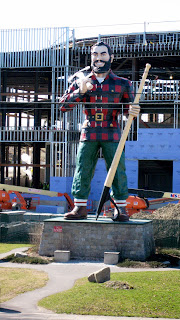 |
| Construction cranes dwarf Bangor's Paul Bunyan statue. |
Seems people have been
discovering Bangor, Maine ever since the Portuguese mariner, Estavan Gomez, a captain in
Magellan’s round-the-world fleet, sailed the La Anunciada up the Penobscot
River in search of the legendary Northwest Passage to the Orient in 1525 under
commission of King Charles V of Spain. French explorer Samuel de Champlain was
also documented to discover the area in 1604. However, the city wasn’t
officially incorporated until 1791 at which time it was named after an Irish Hymn, “Bangor”,
by a pastor from Boston named Seth Noble. A healthy fishing and fur trade drew the
earliest settlers to the area. Then Maine’s vast forests brought wealth beyond
compare to the region making Bangor the lumber capital of the world and one of
the busiest ports on the East Coast by the 1850s. Shipbuilding and shipping commerce
thrived until the twentieth century when pulp and paper industries took their
place. Since then, Bangor’s central location has grown into a social and
economic center for the state and offers the region a wide selection of retail
and service businesses, education and employment opportunities.
Recent
development of Bangor’s waterfront along the Penobscot River has not only
enhanced its beauty, its brought entertainment and cultural growth to the city
in the form of the an annual Folk Festival, Waterfront Concerts, Hollywood
Casino and Raceway, plus revitalization of it’s historic Opera House which
houses the Penobscot Theatre Company. There are also a growing number of
museums and galleries in the area, including Maine Discovery Children’s Museum
and Cole’s Transportation Museum. Its history is very rich, especially in Bass
Park, the home of the Bangor State Fair, one of the oldest in the country, and a raceway
that’s featured harness racing since 1893.
Yes,
there is definitely a lot to discover in and about Bangor, Maine. That’s the
reason why a construction site on Main Street stretches all the way from Dutton
Street to the corner of Buck Street and is changing the view of the entrance to
historic Bass Park once again. Major changes to this block in my lifetime have included
the 1955 opening of the now soon-to-be-demolished, v-roofed Bangor Auditorium.
It was constructed behind an older auditorium, which preceded it, and was the second largest event center in New England at that time. The old structure
was eventually torn down in 1967 leaving a nice park area behind the location
where Bangor’s famous Paul Bunyan statue came to reside in 1959. The 31-foot, fiberglass
and metal woodsman, which Bangor claims as its mythical son, was a gift to the
city on its 125th anniversary and has a time capsule enclosed in its
pedestal that's slated to be opened in 2084. Do not think I'll live to see that, but I have witnessed Paul, the statue,
in an oversized Shriner fez to promote a convention and a bandanna for a Willie Nelson concert in July 1986 (which I have fond behind-the-scenes
memories of ). The Paul
Bunyan statue has even been part of the Stephen King novel, It, and, I dare
say, is possibly photographed more than Stephen King or his Bangor Italianate style mansion
with its surrounding unique, but fitting, bat and spider motif wrought-iron fencing.
In recent years, Hollywood Slots, newly renamed Hollywood Casino, has taken up residence across from the Bass Park entrance, where older hotels and businesses once stood, and
from its parking garage you can easily view construction of the brand new Bangor
Event Center, which will replace the oddly shaped, v-roofed auditorium that stands like a
shadow behind it. This new structure is reclaiming space where the original auditorium once stood and is scheduled to open in July 2013.
As I mentioned earlier, I have fond memories of
the Bangor Auditorium. It’s where I first saw a circus, interviewed Ted Nugent
without any film in my camera, listened to a Willie Nelson concert through a
headset with his lighting director, and attended a grandson’s high school
graduation. Now, I’m getting itchy to see what exciting memories this new arena
might bring to the city of Bangor, and of course, me.







